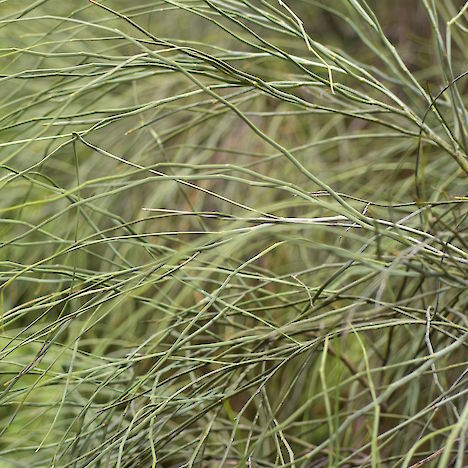Other names:
Notospartium carmichaeliaeThreat category:
Threatened: Nationally Critical?Regions:
MarlboroughDistribution:
Marlborough
Key Features
Native brooms in the genus Carmichaelia have a variety of growth habits, from small trees to low-growing shrubs, and even one climbing species. They have characteristic ‘pea flowers’ which can be very showy in some species. Many grow in areas that have potential for afforestation, and most are susceptible to browsing by stock and feral animals. As a consequence, several species are threatened.
- Shrub to 4 m tall, with slender, drooping, leafless branches.
- The grooved branchlets are compressed and bear dense clusters of pink flowers in early summer.
- Flowers turn into more or less flat pods up to 2 cm long that are contricted between the seeds.
- Marlborough Pink Broom (C. glabrescens) also has pink flowers, but has stouter pods that are not constricted between the seeds.
Distribution and Habitat
- South Island, restricted to the Awatere and Wairau catchments of Marlborough.
- Pink tree broom grows on river flats and in rocky sites from sea level to 1,200 m. Young plants are often confined to areas inaccessible to browsing animals.
Threats
- Habitat modification and loss.
- Browse by stock and feral animals.
- Regeneration failure due to browsing.
Management Opportunities
- Survey for new locations.
- Mark known sites.
- Protection of habitat.
- Collect seed from mature shrubs for propagation and replanting in appropriate sites.
- Exclosures to allow seedling regeneration.
- Control of stock and feral animals such as hares and goats.
- Ensure that forest owners are aware of potential habitats and can recognise the species.
Monitoring Options
- Check existing populations annually
- Report new locations to DOC, NZPCN
Further Information and Support
- New Zealand Plant Conservation Network (NZPCN). http://www.nzpcn.org.nz
- Pest control - Department of Conservation, Regional Councils.
- References
- Salmon (1986). A field guide to the native trees of New Zealand. Reed Methuen, Auckland.
- Poole & Adams (1994). Trees and shrubs of New Zealand. Maanaki Whenua Press, Lincoln.
- Peter de Lange, Peter Heenan, David Norton, Jeremy Rolfe and John Sawyer (2010). Threatened Plants of New Zealand. Canterbury University Press, Christchurch. 472 pp.


